Search results for: 'For'
-
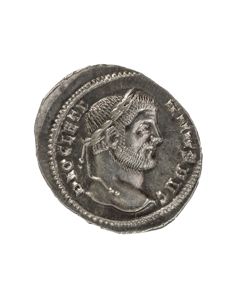 Extremely fine Diocletian argenteus
Extremely fine Diocletian argenteusAbsolutely extremely fine, uncirculated. The RIC states the rarity with R2. In the Occident, Diocletian is (in)famous for the last and largest persecution of Christianity.
Price: on request Roman surgical probe made of silver
Roman surgical probe made of silverThe so-called specillum was standard issue for roman doctors. Similar probes are still in use today. Ancient surgical instruments made of silver are extremely rare.
Price: on request Scaraboid from the Middle Kingdom
Scaraboid from the Middle KingdomThe stamp shows hieroglyphs with a title for the king of Upper and Lower Egypt. This scaraboid is described in the catalogue of Irène Gautier-Vodoz.
Price: on request Very fine Nero Aureus
Very fine Nero AureusThis coin type celebrates the failing of the "Pisonian Conspiracy" and emphasizes the divine protection for emperor Nero. Impressive portrait, condition slightly better than very fine.
Price: on request Roman specillum
Roman specillumThe so-called specillum is a surgical probe. It was standard issue for roman doctors. Similar probes are still in use today. 1st to 4th cent. AD.
Price: on request Scarab with cartouche of Thutmose III.
Scarab with cartouche of Thutmose III.Amulet from the New Kingdom for one of the most popular rulers in ancient Egyptian history. This scarab is described in the catalogue of Irène Gautier-Vodoz.
Price: on request Egyptian faience ring showing Bes and Taweret
Egyptian faience ring showing Bes and TaweretThe finger ring with its scene on the plate must have served a protective function for an expectant mother. New Kingdom, approx. 1550 to 1070 BC.
Price: on request Small scarab amulet with Isis hieroglyphs
Small scarab amulet with Isis hieroglyphsThe tiny amulet dates to the New Kingdom. It bears the glyphs for the goddess Isis. This scarab is described in the catalogue of Irène Gautier-Vodoz.
Price: on request Group of 3 Scythian-Greek arrow heads
Group of 3 Scythian-Greek arrow headsCharacteristically shaped ancient bronze arrow heads. With three wings and barbed hooks. Perfect condition with lovely patina. Typical for the Scythians from 700 BC to hellenistic times.
Price: on request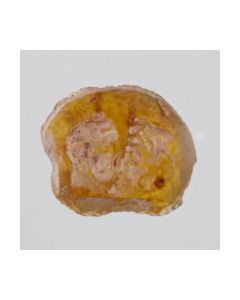 Roman intaglio with two facing heads
Roman intaglio with two facing headsThis special motive for Roman engraved gems often featured two Roman citizens or man and wife. It is an interesting example of its kind made from beautiful orange glass.
Price: on request Pair of pins with chain
Pair of pins with chainThe pair of pins dates to the early Iron Age of Luristan. It is made from Bronze and Iron. This state of preservation is extremely rare for composite objects.
Price: on request Base plate of a Roman mirror
Base plate of a Roman mirrorPerfectly preserved bronze plate of a Roman mirror. A handle and reflective metal coating were once part of the object. Typical for upper class Roman households during Imperial times.
€295 Roman oil lamp showing emperor Claudius
Roman oil lamp showing emperor ClaudiusVery rare depiction of this Roman emperor on a piece of pottery intended for daily use. Very well preserved, worth the exhibition in a museum. Coming with an Art Loss certificate.
Price: on request Imposing eye idol from Mesopotamia
Imposing eye idol from MesopotamiaThe highly abstract figure was made in northern Mesopotamia, probably in northern Iraq. A wonderful piece from the late 4th Millennium BC.
€15,400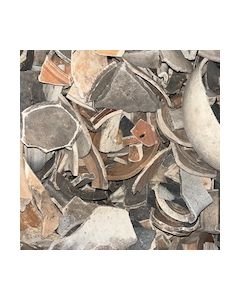 Roman potsherds from the Rhineland - sold by weight
Roman potsherds from the Rhineland - sold by weightFragments of Roman pottery. Finds from the Roman city of Novaesium, today's Neuss in Germany, an early Roman foundation and with this one of the oldest cities in Germany.
€75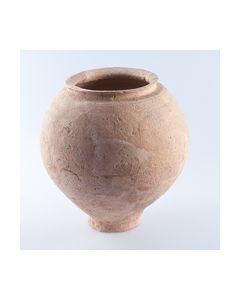 Mittelgroße römische Graburne
Mittelgroße römische GraburneHellrote Keramik, gut restauriert. Beeindruckendes Objekt.
Price: on request Base plate of a Roman mirror
Base plate of a Roman mirrorThe bronze disc is the base plate of a Roman mirror. A handle and reflective metal coating were once part of the mirror. Typical for upper class Roman households during Imperial times.
Price: on request Colorful Roman glass balsamarium
Colorful Roman glass balsamariumThe small flask was probably used for perfume or other scented oils. This type of vessel was used throughout the Roman trade markets. The play of colours on the surface is wonderful.
Price: on request Applique of the Horus son Duamutef
Applique of the Horus son DuamutefBright turquise fayence. Duamutef is one of the four sons of Horus, well-known from the Canopic jars. He had an important protective function for the dead. Egypt, 8th to 4th cent. BC.
Price: on request Lekythos from Toledo Museum collection
Lekythos from Toledo Museum collectionEx collection Prof. G. Olcott, the first Columbia University professor for Roman archeology. Acquired from his estate 1912 by the Toledo Museum (Ohio), in the museum collection until 2017. Found in Apulia.
Price: on request Slender Egyptian stone beaker
Slender Egyptian stone beakerThe small and tall stone vessel is made of alabaster. From the collection of Egyptologist Professor Wiedemann.
Price: on request Egyptian overseer figurine
Egyptian overseer figurineFrom a 22nd dynasty tomb containing a large number of ushabtis. Their work performance in the afterlife was to be ensured by the overseer figurine.
Price: on request Gourd shaped bowl of the Chimú culture
Gourd shaped bowl of the Chimú cultureElegant bowl with shiny black surface. Precolumbian pottery of the 10th to 15th century.
Price: on request Greek skyphos: Italic imitation of Proto-Corinthian or Laconian pottery
Greek skyphos: Italic imitation of Proto-Corinthian or Laconian potteryAbout late 7th - 6th century B.C. From the Austrian collection of Prof. Ritschel, carrier of the Large Cross of Honor of the Austrian Republic and many other prizes and honors. Very nicely preserved, interesting unusual piece.
Price: on request Roman sprinkler
Roman sprinklerPerfume bottle with pattern-blown body. An aperture made it easy to dispense the precious content drop by drop. Made in the Roman province Syria in the 3rd cent. AD.
Price: on request Roman sprinkler
Roman sprinklerPerfume bottle with pattern-blown body. An aperture made it easy to dispense the precious content drop by drop. From the Late Roman period.
Price: on request Titus denarius from Wishanger hoard
Titus denarius from Wishanger hoardGreat dark patina. Found 2021 in East Hampshire, UK. The hoard is a very impressive proof of the fact that coins were in circulation for up to several centuries in the Roman era.
Price: on request Egyptian stone beaker
Egyptian stone beakerThe elegant stone vase was probably used as an ointment vessel. 5th to 6th dynasty of ancient Egypt, Old Kingdom.
Price: on request Roman and medieval potsherds from the Rhineland
Roman and medieval potsherds from the RhinelandFragments of Roman and medieval pottery. Finds from the Roman city of Novaesium, today's Neuss in Germany, an early Roman foundation and with this one of the oldest cities in Germany.
Price: on request Roman potsherds from the Rhineland
Roman potsherds from the RhinelandFragments of Roman pottery. Finds from the Roman city of Novaesium, today's Neuss in Germany, an early Roman foundation and with this one of the oldest cities in Germany.
Price: on request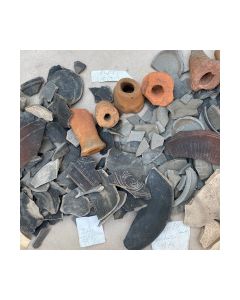 Roman potsherds from the Rhineland
Roman potsherds from the RhinelandFragments of Roman pottery. Finds from the Roman city of Novaesium, today's Neuss in Germany, an early Roman foundation and with this one of the oldest cities in Germany.
Price: on request Roman potsherds from the Rhineland
Roman potsherds from the RhinelandFragments of Roman pottery. Finds from the Roman city of Novaesium, today's Neuss in Germany, an early Roman foundation and with this one of the oldest cities in Germany.
Price: on request Roman potsherds from the Rhineland
Roman potsherds from the RhinelandFragments of Roman pottery. Finds from the Roman city of Novaesium, today's Neuss in Germany, an early Roman foundation and with this one of the oldest cities in Germany.
Price: on request Roman potsherds from the Rhineland
Roman potsherds from the RhinelandFragments of Roman pottery. Finds from the Roman city of Novaesium, today's Neuss in Germany, an early Roman foundation and with this one of the oldest cities in Germany.
Price: on request Roman potsherds from the Rhineland
Roman potsherds from the RhinelandFragments of Roman pottery. Finds from the Roman city of Novaesium, today's Neuss in Germany, an early Roman foundation and with this one of the oldest cities in Germany.
Price: on request Roman potsherds from the Rhineland
Roman potsherds from the RhinelandFragments of Roman pottery. Finds from the Roman city of Novaesium, today's Neuss in Germany, an early Roman foundation and with this one of the oldest cities in Germany.
Price: on request

